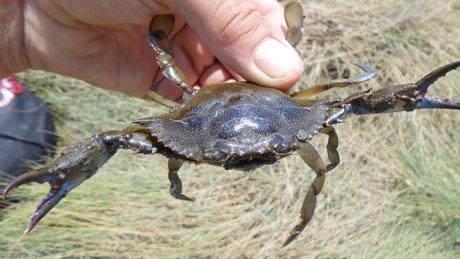Is the tasty blue crab's natural range creeping north?

This is a blue crab, Callinectes sapidus, caught in Ipswich, Mass., 80 miles north of its historical native range. Credit: David Samuel Johnson
The historic northern limit of this species of crab (also called Atlantic blue or Chesapeake blue) is Cape Cod, Mass. They typically weren't found in the Gulf of Maine due to its cold Canadian waters.
From 2012 to 2014, however, scientists and resource managers observed blue crabs as far north as northern Maine and Nova Scotia, Canada. Johnson hypothesizes that warmer ocean temperatures in 2012 and 2013, which were 1.3°C higher than the previous decade's average, allowed the crabs to move north.
“Climate change is lowering the thermal barriers that kept species from moving toward the poles,” he says. “Climate change presents a challenge not only for ecologists, but for fisheries managers as commercially important species shift their ranges in response to warming oceans.”
Ephemeral populations of blue crabs have been documented previously in the Gulf of Maine. Johnson notes that in the 1950s blue crabs were observed in the gulf during a time of warmer waters. But once the waters returned to average temperatures, the crabs disappeared.
“It's too early to determine if the current blue crab population in the Gulf of Maine is permanent or ephemeral,” Johnson says. “However, models predict an increasing warming of the world's oceans and recent observations of blue crabs may be a crystal ball into the future ecology of the Gulf of Maine.”
Other researchers have documented the northern movement of other commercially important species in northeastern United States such as lobsters, hake and flounder. Johnson's work, however, is the first to document the movement of a commercially important species into the Gulf of Maine.
This is the second crustacean Johnson has documented as expanding into the Gulf of Maine. In 2014 he published his findings on the rapid expansion of the fiddler crab, Uca pugnax, into the gulf. “As the world's oceans continue to warm, we will continue to see climate-driven range expansions,” he predicts.
###
Johnson, now an adjunct assistant scientist at the MBL, recently joined the Virginia Institute of Marine Science as an assistant professor.
Citation:
Johnson DS (2015) The savory swimmer swims north: a northern range extension of the blue crab Callinectes sapidus? J. Crustacean Biology 35: 105-110.
The Marine Biological Laboratory (MBL) is dedicated to scientific discovery and improving the human condition through research and education in biology, biomedicine, and environmental science. Founded in Woods Hole, Massachusetts, in 1888, the MBL is a private, nonprofit institution and an affiliate of the University of Chicago.
Media Contact
All latest news from the category: Life Sciences and Chemistry
Articles and reports from the Life Sciences and chemistry area deal with applied and basic research into modern biology, chemistry and human medicine.
Valuable information can be found on a range of life sciences fields including bacteriology, biochemistry, bionics, bioinformatics, biophysics, biotechnology, genetics, geobotany, human biology, marine biology, microbiology, molecular biology, cellular biology, zoology, bioinorganic chemistry, microchemistry and environmental chemistry.
Newest articles

Why getting in touch with our ‘gerbil brain’ could help machines listen better
Macquarie University researchers have debunked a 75-year-old theory about how humans determine where sounds are coming from, and it could unlock the secret to creating a next generation of more…

Attosecond core-level spectroscopy reveals real-time molecular dynamics
Chemical reactions are complex mechanisms. Many different dynamical processes are involved, affecting both the electrons and the nucleus of the present atoms. Very often the strongly coupled electron and nuclear…

Free-forming organelles help plants adapt to climate change
Scientists uncover how plants “see” shades of light, temperature. Plants’ ability to sense light and temperature, and their ability to adapt to climate change, hinges on free-forming structures in their…





















